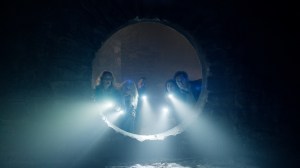Fight Club and Choke author Chuck Palahniuk is pushing boundaries again — this time with Bait, his spin on the adult coloring book craze.
Videos by ComicBook.com
A series of short prose stories featuring dozens of new illustrations from comics royalty like David Mack, Duncan Fegredo, and Lee Bermejo, Palahniuk’s Bait: Off Color Stories For You To Color goes on sale today from Dark Horse Comics.
The oversized hardcover features eight short stories comprising almost 150 pages of material, illustrations included. The images themselves — you can see a sampling in the attached image gallery — range from the mundane to the disturbing to…well…Palahniuk’s author portrait, here drawn by Fight Club 2 cover artist David Mack rather than taken as a photograph.
“It could be that I’m attracted to conflict and tension; for instance, upsetting stories told in the form of a coloring book, a pastime normally designed to help people relax,” Palahniuk said of his decision to make the book full of original content — and often pretty dark content, at that — which readers will likely feel obliged to scrutinize more closely than if it were an anthology collection of previously-published work, as most coloring books published by comic book publishers have been. “The absurd never fails to attract me. After a lifetime of consuming narratives filled with social engineering designed to ‘fix’ me, I just want to have a good time. Most of us abandoned reading after our school years because the assignments were so clearly lessons in good citizenship.”
And he wants his readers to have that same good time. To that degree, the author says, there won’t be a forthcoming paperback edition with lavishly colored art from superstar colorist Dave Stewart (Fight Club 2) or someone like him.
“When people come to me with their interpretations of my stories, the secret meanings they’ve dissected out, I always tell them they’re right,” Palahniuk told ComicBook.com. “Fiction is the Rorschach Test in which you want readers to find their own meaning, based on their own experience. Coloring becomes an extension of that participation with the story. An official, colored version would dictate a ‘correct’ way to complete the book – and preclude that deeper participation.”

He added that “Bait will never be issued as a paperback; the point of the project was to offer something well made and worth the time required to personalize it.”
This is far from the first time Palahniuk has toyed with the structure of a work; in Fight Club, his narrator wasn’t just unreliable, but anonymous and, ultimately, psychotic. In Diary, the story hinged on the often-disconnected thought process of a writer who was ostensibly not speaking for an audience.
“To me, every story is an experiment. And the format of the story should be unique, designed to complement that particular story,” Palahniuk explained. “So a good story includes a unique plot, a unique voice or language, and a unique format. Whether it’s the rules in Fight Club or the reversed page numbers in Survivor there has to be something distinct that lingers in the reader’s mind.”
And, even in a coloring book, Palahniuk wanted that lingering remnant to be more than just the art. He never considered making this one a comic book, even though he published through Dark Horse. While he loved working with editor Scott Allie again, Palahniuk said, there was something else he was going for that superseded any potential temptation to follow up as another comic book.
“If anything, I wanted the stories to be a little too language-rich,” said Palahniuk. “They use repeating words like ‘Dad’ and ‘until’ to create a rhythm, because I was trying to recreate the drum machine sound of my favorite 1980’s music. Like ‘Heartbreak Beat,’ where the drum line is just boom-boom-boom. Repeating words drop out as the reader stops subvocalizing them, and they become little beats of blank time. You can control the pace – the beat – of a story/song by using more or fewer of the repetitive words. I’ll go nuts, trying to make stories work more like songs.”
That’s a strategy that was especially prevalent in Fight Club, Palahniuk’s wildly successful debut novel. While some of the repetition had a specific story purpose — some of that has become widely discussed becuase of the cult status David Fincher’s film adaptation enjoys — there was quite a lot of repetition that never made it to the movie, or at least that wasn’t played up in the same way as “His name was Robert Paulsen.”
Part of that could be a byproduct of — once again — Palahniuk exploring unconventional ways of developing the novel. The book’s sixth chapter was originally a seven-page short story published in the compilation Pursuit of Happiness. Palahniuk says that while hardcore fans of his work might have tracked that original printing down over the years, the whole novel could have been a series of unrelated short stories.
“Most of my novels actually begin as a series of short stories. That was the case with Fight Club: there was a story about going to support groups for the terminally ill (which becomes the cute meet), the story about inventing fight clubs, the story about peeing in soup at a hotel,” Palahniuk told us. “Each is similar to the sketch or study an artist might do to establish each element of a painting before executing the larger composition.”
Now, of course, it’s your turn to play a part in the execution and composition of Palahniuk’s work. Just remember: the second rule is not to color outside the lines (unless you want to).
Bait is in comic stores and bookshops now.








